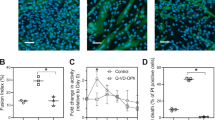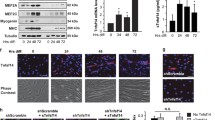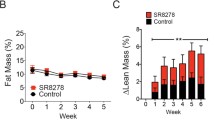Abstract
Apoptosis rather than differentiation is a physiological process during myogenesis and muscle regeneration. When cultured myoblasts were induced to differentiate, we detected an increase in caspase 8 activity. Pharmacological inhibition of caspase 8 activity decreased apoptosis. Expression of a dominant-negative mutant of the adapter protein FADD also abrogated apoptosis, implicating a death ligand pathway. Treatment with TRAIL, but not Fas, induced apoptosis in these myoblasts. Accordingly, treatment with a soluble TRAIL decoy receptor or expression of a dominant-negative mutant of the TRAIL receptor DR5 abrogated apoptosis. While TRAIL expression levels remained unaltered in apoptotic myoblasts, DR5 expression levels increased. Finally, we also detected a reduction in FLIP, a death-receptor effector protein and caspase 8 competitive inhibitor, to undetectable levels in apoptotic myoblasts. Thus, our data demonstrate an important role for the TRAIL/DR5/FADD/caspase 8 pathway in the apoptosis associated with skeletal myoblast differentiation. Identifying the functional apoptotic pathways in skeletal myoblasts may prove useful in minimizing the myoblast apoptosis that contributes pathologically to a variety of diseases and in minimizing the apoptosis of transplanted myoblasts to treat these and other disease states.






Similar content being viewed by others

Abbreviations
- FADD:
-
Fas-associated death domain
- TRAIL:
-
Tumor necrosis factor related apoptosis-inducing ligand
- FLIP:
-
FADD-like IL-1-converting enzyme-inhibitory protein
References
Raff MC (1992) Social controls on cell survival and cell death. Nature 356:397–00
Fidzianska A, Goebel HH (1991) Human ontogenesis 3. Cell death in fetal muscle. Acta Neuropathol (Berl) 81:572–77
Miller JB, Stockdale FE (1986) Developmental regulation of the multiple myogenic cell lineages of the avian embryo. J Cell Biol 103:2197–208
Sandri MC, Massimino ML, Geromel V, Arslan P (1996) Myoblasts and myotubes in primary cultures deprived of growth factors undergo apoptosis. Basic Appl Myol 6:257–60
Chinni C, de Niese MR, Tew DJ, Jenkins AL, Bottomley SP, Mackie EJ (1999) Thrombin, a survival factor for cultured myoblasts. J Biol Chem 274:9169–174
Wang J, Walsh K (1996) Resistance to apoptosis conferred by Cdk inhibitors during myocyte differentiation. Science 273:359–61
Dee K, Freer M, Mei Y, Weyman CM (2002) Apoptosis coincident with the differentiation of skeletal myoblasts is delayed by caspase 3 inhibition and abrogated by MEK-independent constitutive Ras signaling. Cell Death Differ 9:209–18
Mampuru LJ, Chen SJ, Kalenik JL, Bradley ME, Lee TC (1996) Analysis of events associated with serum deprivation-induced apoptosis in C3H/Sol8 muscle satellite cells. Exp Cell Res 226:372–80
Skuk D, Tremblay JP (2000) Progress in myoblast transplantation: a potential treatment of dystrophies. Microsc Res Tech 48:213–22
Bouchentouf M, Benabdallah BF, Tremblay JP (2004) Myoblast survival enhancement and transplantation success improvement by heat-shock treatment in mdx mice. Transplantation 77:1349–356
Olson EN (1992) Interplay between proliferation and differentiation within the myogenic lineage. Dev Biol 154:261–72
Sandri M, Carraro U (1999) Apoptosis of skeletal muscles during development and disease. Int J Biochem Cell Biol 31:1373–390
Sandri M, El Meslemani AH, Sandri C et al (2001) Caspase 3 expression correlates with skeletal muscle apoptosis in Duchenne and facioscapulo human muscular dystrophy. A potential target for pharmacological treatment? J Neuropathol Exp Neurol 60:302–12
Yang Y, Kaul S, Zhang D, Anantharam V, Kanthasamy AG (2004) Suppression of caspase-3-dependent proteolytic activation of protein kinase C delta by small interfering RNA prevents MPP+-induced dopaminergic degeneration. Mol Cell Neurosci 25:406–21
Nagy Z, Simon L (2004) Neuroprotection in ischemic/hypoxic disorders: from the preclinical to the clinical testing. Adv Exp Med Biol 541:39–4
Przedborski S (2004) Programmed cell death in amyotrophic lateral sclerosis: a mechanism of pathogenic and therapeutic importance. Neurologist 10:1–
Sheikh MS, Huang Y (2004) Death receptors as targets of cancer therapeutics. Curr Cancer Drug Targets 4:97–04
Debatin KM, Krammer PH (2004) Death receptors in chemotherapy and cancer. Oncogene 23:2950–966
DeChant AK, Dee K, Weyman CM (2002) Raf-induced effects on the differentiation and apoptosis of skeletal myoblasts are determined by the level of Raf signaling: abrogation of apoptosis by Raf is downstream of caspase 3 activation. Oncogene 21:5268–279
Nakanishi K, Sudo T, Morishima N (2005) Endoplasmic reticulum stress signaling transmitted by ATF6 mediates apoptosis during muscle development. J Cell Biol 169:555–60
Kroemer G (1999) Mitochondrial control of apoptosis: an overview. Biochem Soc Symp 66:1–5
Kuwana T, Newmeyer DD (2003) Bcl-2-family proteins and the role of mitochondria in apoptosis. Curr Opin Cell Biol 15:691–99
Orrenius S (2004) Mitochondrial regulation of apoptotic cell death. Toxicol Lett 149:19–3
Thorburn A (2004) Death receptor-induced cell killing. Cell Signal 16:139–44
Salvesen GS, Dixit VM (1997) Caspases: intracellular signaling by proteolysis. Cell 91:443–46
Budihardjo I, Oliver H, Lutter M, Luo X, Wang X (1999) Biochemical pathways of caspase activation during apoptosis. Annu Rev Cell Dev Biol 15:269–90
Li H, Zhu H, Xu CJ, Yuan J (1998) Cleavage of BID by caspase 8 mediates the mitochondrial damage in the Fas pathway of apoptosis. Cell 94:491–01
Luo X, Budihardjo I, Zou H, Slaughter C, Wang X (1998) Bid, a Bcl2 interacting protein, mediates cytochrome c release from mitochondria in response to activation of cell surface death receptors. Cell 94:481–90
Wang J, Guo K, Wills KN, Walsh K (1997) Rb functions to inhibit apoptosis during myocyte differentiation. Cancer Res 57:351–54
Guo K, Walsh K (1997) Inhibition of myogenesis by multiple cyclin-Cdk complexes. Coordinate regulation of myogenesis and cell cycle activity at the level of E2F. J Biol Chem 272:791–97
Lawlor MA, Rotwein P (2000) Coordinate control of muscle cell survival by distinct insulin-like growth factor activated signaling pathways. J Cell Biol 151:1131–140
Lawlor MA, Rotwein P (2000) Insulin-like growth factor-mediated muscle cell survival: central roles for Akt and cyclin-dependent kinase inhibitor p21. Mol Cell Biol 20:8983–995
Lawlor MA, Feng X, Everding DR, Sieger K, Stewart CE, Rotwein P (2000) Dual control of muscle cell survival by distinct growth factor-regulated signaling pathways. Mol Cell Biol 20:3256–265
Reuveny M, Heller H, Bengal E (2004) RhoA controls myoblast survival by inducing the phosphatidylinositol 3-kinase-Akt signaling pathway. FEBS Lett 569:129–34
Jin Z, El-Deiry WS (2005) Overview of cell death signaling pathways. Cancer Biol Ther 4:139–63
Chinnaiyan AM, O’Rourke K, Tewari M, Dixit VM (1995) FADD, a novel death domain-containing protein, interacts with the death domain of Fas and initiates apoptosis. Cell 81:505–12
Ray S, Almasan A (2003) Apoptosis induction in prostate cancer cells and xenografts by combined treatment with Apo2 ligand/tumor necrosis factor-related apoptosis-inducing ligand and CPT-11. Cancer Res 63:4713–723
Dee K, DeChant A, Weyman CM (2003) Differential signaling through NFkappaB does not ameliorate skeletal myoblast apoptosis during differentiation. FEBS Lett 545:246–52
Kawahara A, Enari M, Talanian RV, Wong WW, Nagata S (1998) Fas-induced DNA fragmentation and proteolysis of nuclear proteins. Genes Cells 3:297–06
Wolfman JC, Palmby T, Der CJ, Wolfman A (2002) Cellular N-Ras promotes cell survival by downregulation of Jun N-terminal protein kinase and p38. Mol Cell Biol 22:1589–606
Almasan A, Ashkenazi A (2003) Apo2L/TRAIL: apoptosis signaling, biology, and potential for cancer therapy. Cytokine Growth Factor Rev 14:337–48
MacFarlane M, Ahmad M, Srinivasula SM, Fernandes-Alnemri T, Cohen GM, Alnemri ES (1997) Identification and molecular cloning of two novel receptors for the cytotoxic ligand TRAIL. J Biol Chem 272:25417–5420
Roth W, Reed JC (2004) FLIP protein and TRAIL-induced apoptosis. Vitam Horm 67:189–06
Zhang K, Kaufman RJ (2006) The unfolded protein response: a stress signaling pathway critical for health and disease. Neurology 66:S102–S109
Wu GS, Burns TF, McDonald ER 3rd et al (1997) KILLER/DR5 is a DNA damage-inducible p53-regulated death receptor gene. Nat Genet 17:141–43
Burns TF, Bernhard EJ, El-Deiry WS (2001) Tissue specific expression of p53 target genes suggests a key role for KILLER/DR5 in p53-dependent apoptosis in vivo. Oncogene 20:4601–612
Cerone MA, Marchetti A, Bossi G, Blandino G, Sacchi A, Soddu S (2000) p53 is involved in the differentiation but not in the differentiation-associated apoptosis of myoblasts. Cell Death Differ 7:506–08
Algeciras-Schimnich A, Griffith TS, Lynch DH, Paya CV (1999) Cell cycle-dependent regulation of FLIP levels and susceptibility to Fas-mediated apoptosis. J Immunol 162:5205–211
Mercer SE, Ewton DZ, Deng X, Lim S, Mazur TR, Friedman E (2005) Mirk/Dyrk1B mediates survival during the differentiation of C2C12 myoblasts. J Biol Chem 280:25788–5801
Peschiaroli A, Figliola R, Coltella L et al (2002) MyoD induces apoptosis in the absence of RB function through a p21(WAF1)-dependent re-localization of cyclin/cdk complexes to the nucleus. Oncogene 21:8114–127
Fukazawa T, Fujiwara T, Uno F et al (2001) Accelerated degradation of cellular FLIP protein through the ubiquitin-proteasome pathway in p53-mediated apoptosis of human cancer cells. Oncogene 20:5225–231
Zhang HG, Wang J, Yang X, Hsu HC, Mountz JD (2004) Regulation of apoptosis proteins in cancer cells by ubiquitin. Oncogene 23:2009–015
Suhara T, Mano T, Oliveira BE, Walsh K (2001) Phosphatidylinositol 3-kinase/Akt signaling controls endothelial cell sensitivity to Fas-mediated apoptosis via regulation of FLICE-inhibitory protein (FLIP). Circ Res 89:13–9
Skurk C, Maatz H, Kim HS et al (2004) The Akt-regulated forkhead transcription factor FOXO3a controls endothelial cell viability through modulation of the caspase-8 inhibitor FLIP. J Biol Chem 279:1513–525
Karasarides M, Dee K, Schulman D, Wolfman A, Weyman CM (2006) Active Ras-induced effects on skeletal myoblast differentiation and apoptosis are independent of constitutive PI3-kinase activity. Cell Biol Int
Panka DJ, Mano T, Suhara T, Walsh K, Mier JW (2001) Phosphatidylinositol 3-kinase/Akt activity regulates c-FLIP expression in tumor cells. J Biol Chem 276:6893–896
Wang Q, Wang X, Hernandez A, Hellmich MR, Gatalica Z, Evers BM (2002) Regulation of TRAIL expression by the phosphatidylinositol 3-kinase/Akt/GSK-3 pathway in human colon cancer cells. J Biol Chem 277:36602–6610
Gilley J, Coffer PJ, Ham J (2003) FOXO transcription factors directly activate bim gene expression and promote apoptosis in sympathetic neurons. J Cell Biol 162:613–22
Cretney E, Takeda K, Yagita H, Glaccum M, Peschon JJ, Smyth MJ (2002) Increased susceptibility to tumor initiation and metastasis in TNF-related apoptosis-inducing ligand-deficient mice. J Immunol 168:1356–361
Finnberg N, Gruber JJ, Fei P et al (2005) DR5 knockout mice are compromised in radiation-induced apoptosis. Mol Cell Biol 25:2000–013
Zhang J, Cado D, Chen A, Kabra NH, Winoto A (1998) Fas-mediated apoptosis and activation-induced T-cell proliferation are defective in mice lacking FADD/Mort1. Nature 392:296–300
Yeh WC, Pompa JL, McCurrach ME et al (1998) FADD: essential for embryo development and signaling from some, but not all, inducers of apoptosis. Science 279:1954–958
Yeh WC, Itie A, Elia AJ et al (2000) Requirement for Casper (c-FLIP) in regulation of death receptor-induced apoptosis and embryonic development. Immunity 12:633–42
Varfolomeev EE, Schuchmann M, Luria V et al (1998) Targeted disruption of the mouse Caspase 8 gene ablates cell death induction by the TNF receptors, Fas/Apo1, and DR3 and is lethal prenatally. Immunity 9:267–76
Ellis RE, Yuan JY, Horvitz HR (1991) Mechanisms and functions of cell death. Annu Rev Cell Biol 7:663–98
Taylor DA, Atkins BZ, Hungspreugs P et al (1998) Regenerating functional myocardium: improved performance after skeletal myoblast transplantation. Nat Med 4:929–33
Scorsin M, Hagege A, Vilquin JT et al (2000) Comparison of the effects of fetal cardiomyocyte and skeletal myoblast transplantation on postinfarction left ventricular function. J Thorac Cardiovasc Surg 119:1169–175
Suzuki K, Murtuza B, Smolenski RT et al (2001) Cell transplantation for the treatment of acute myocardial infarction using vascular endothelial growth factor-expressing skeletal myoblasts. Circulation 104:I207–I212
Skuk D, Tremblay JP (2003) Cell therapies for inherited myopathies. Curr Opin Rheumatol 15:723–29
Skuk D, Tremblay JP (2003) Myoblast transplantation: the current status of a potential therapeutic tool for myopathies. J Muscle Res Cell Motil 24:285–00
Skuk D, Caron NJ, Goulet M, Roy B, Tremblay JP (2003) Resetting the problem of cell death following muscle-derived cell transplantation: detection, dynamics and mechanisms. J Neuropathol Exp Neurol 62:951–67
Acknowledgment
We thank A. Almasan (Learner Research Institute, Cleveland Clinic), V. Dixit (Genetech, Inc.) and E.S.Alnemri (Thomas Jefferson University) for generously providing the dnFADD and dnDR5 constructs. This work was supported by an NIH RO1 CA84212 awarded to C.M. Weyman.
Author information
Authors and Affiliations
Corresponding author
Rights and permissions
About this article
Cite this article
O’Flaherty, J., Mei, Y., Freer, M. et al. Signaling through the TRAIL receptor DR5/FADD pathway plays a role in the apoptosis associated with skeletal myoblast differentiation. Apoptosis 11, 2103–2113 (2006). https://doi.org/10.1007/s10495-006-0196-4
Published:
Issue Date:
DOI: https://doi.org/10.1007/s10495-006-0196-4



